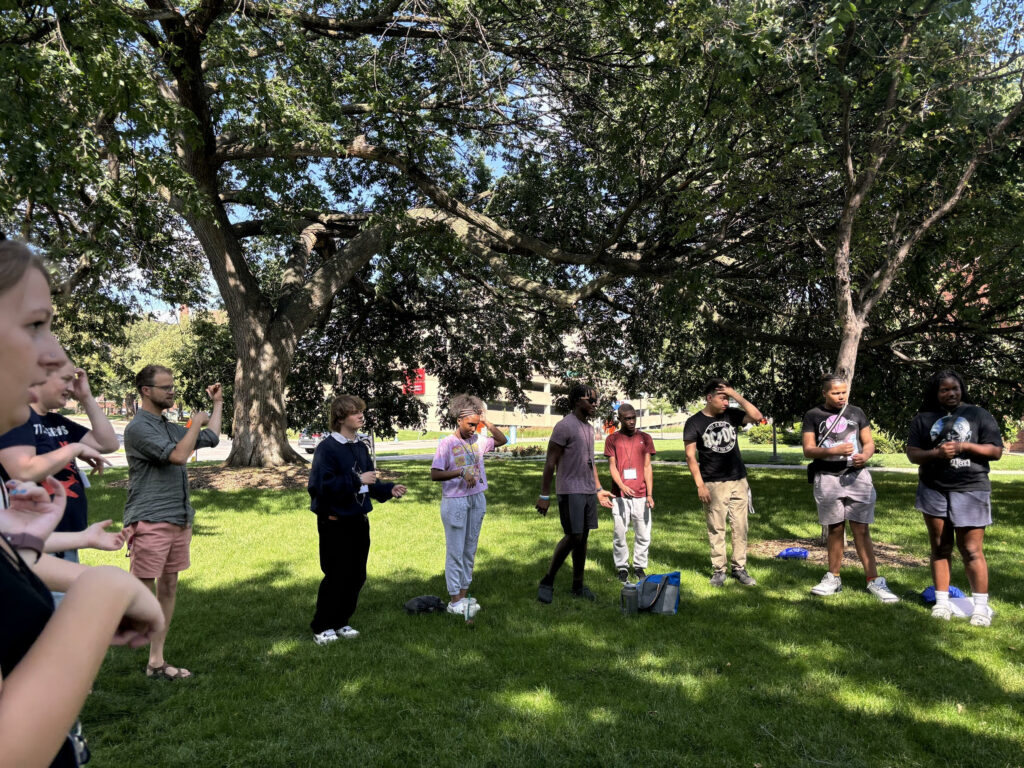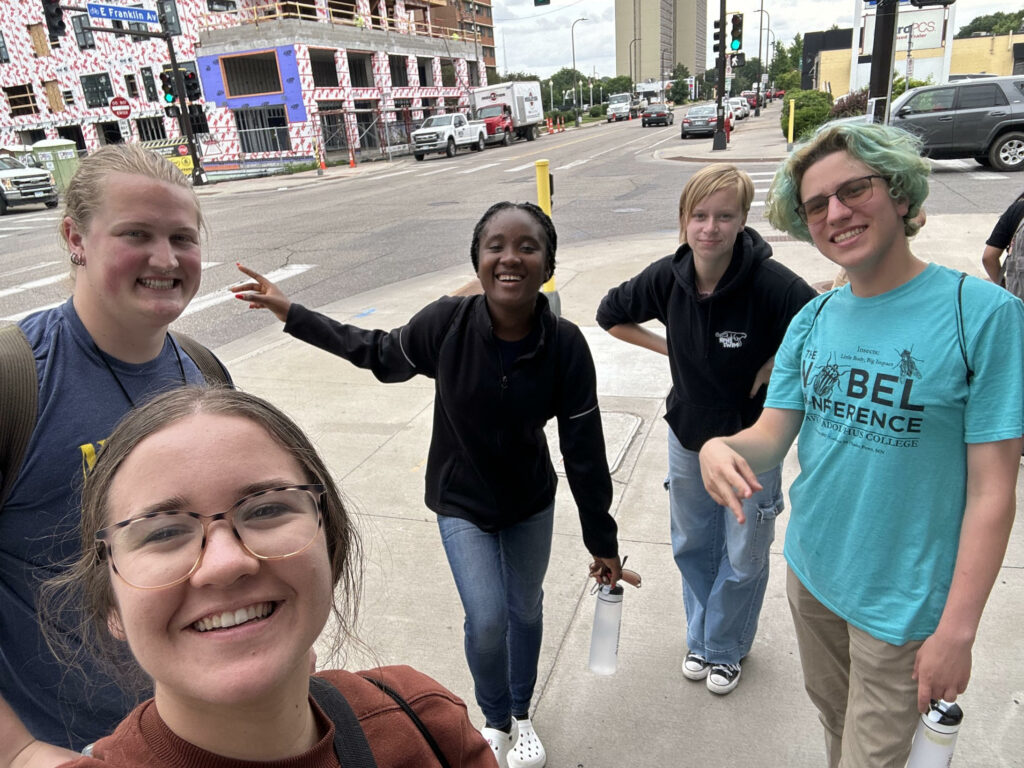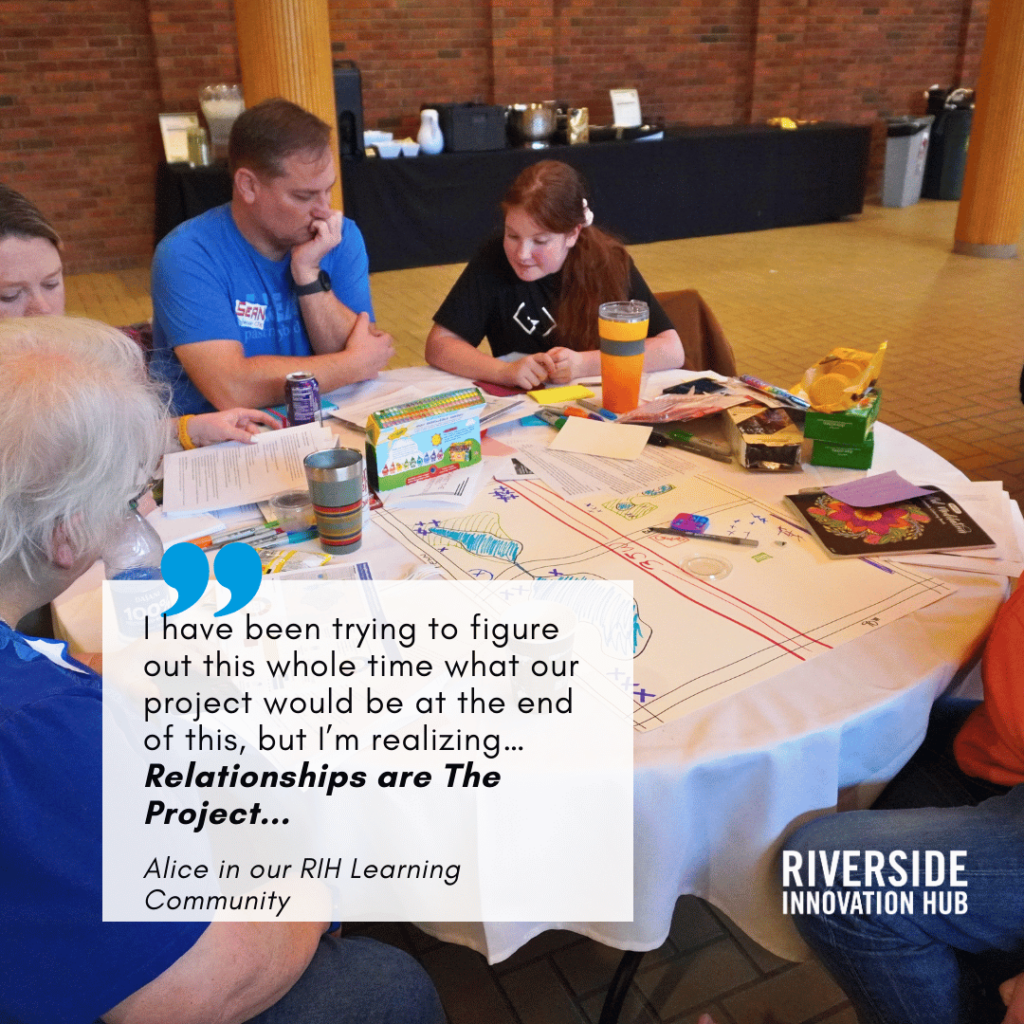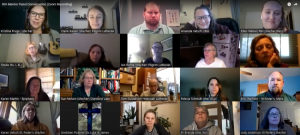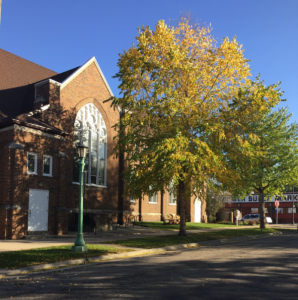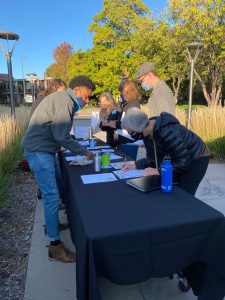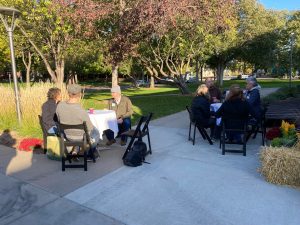By Jeremy Myers, PhD
The Public Church Framework begins in accompaniment. This sounds and looks great on paper, but we have found many leaders and congregations struggle with this artform. They struggle with putting it into practice. They even struggle with the word. So, it is important to explain what accompaniment is, what it is not, why it is important, and how it might be practiced.
What is it?
 Accompaniment is the word we use to describe the first artform, or movement, of the Public Church Framework. It is used to describe a faith community’s movement out into its neighborhood or context. It assumes a desire to know the neighbor, and their story, in their own words. It assumes our neighbor is not just “everyone in God’s creation”, but is also those who live right next-door — people, institutions, systems, watersheds, grove of trees, herds of cattle, and other creatures around us.
Accompaniment is the word we use to describe the first artform, or movement, of the Public Church Framework. It is used to describe a faith community’s movement out into its neighborhood or context. It assumes a desire to know the neighbor, and their story, in their own words. It assumes our neighbor is not just “everyone in God’s creation”, but is also those who live right next-door — people, institutions, systems, watersheds, grove of trees, herds of cattle, and other creatures around us.
Accompaniment takes seriously the location in which our faith communities are planted and challenges us to do the intentional work of getting to know these places and those who call these places home. We do this become we believe God is already at work bringing about redemption in these places. Accompaniment is a way for us to uncover the work God is already doing in our neighborhoods. Accompaniment happens as our faith communities engage their neighborhoods and neighbors in order to (1) hear how they are already experiencing wholeness, healing, redemption, reconciliation and (2) how the faith community might come alongside their neighbors as they seek these things. If our faith communities want to proclaim good news into people’s’ lives, then we first have to do the hard work of listening to our neighbors’ stories.
What is it NOT?
Accompaniment is often misunderstood in some particular ways. Therefore, it is helpful to be explicit about what accompaniment is not.
- Accompaniment is NOT searching for a problem to solve. It is not a way in which we look for something to fix.
- Accompaniment is NOT market research. We are not conducting a survey in order to discover what type of church our neighbors wish to join.
- Accompaniment is NOT agenda-driven. It is not a process of listening to others in order to find ways they might fit into the work you are planning. Accompaniment prioritizes the neighbor and their story.
Why is it important?
The artform of accompaniment is important for several reasons. Some theological and some practical.
It is important theologically because we confess faith in a God who accompanies creation. The God of scripture creates a world of accompaniment where humans, other creatures, vegetation, climate, etc. accompany and provide for one another — for better or worse. God’s creative word that brings about this creation becomes incarnate in Jesus Christ who is God’s word accompanying (dwelling with) us. God’s spirit continues to free us and empower us to be in accompaniment with one another. Therefore, accompaniment becomes the way in which we live out God’s mission in our world and specifically in our neighborhoods.
Accompaniment is also important for practical reasons. The reality is that fewer people are seeking to be involved in faith communities. If we wish to play a meaningful role in people’s’ lives, then we will need to seek them out and engage them in the places where they live their lives rather than expecting them to show up in our places. Lastly, if faith communities want their members to learn to live into God’s mission in their daily lives, then faith communities will need to practice this together. Our faith, and Christ’s love, compels us to accompany our neighbors.
How is it practiced?
There are endless ways to practice accompaniment and the Public Church Framework resists prescribing best practices. It is the work of God’s people to learn how to put accompaniment into practice in ways that match their context, their neighbors’ needs, and their own assets. That said, here are a few ways to get started.
- Neighborhood Prayer Walk —Learn to practice the Ignatian Awareness Examen, a contemplative prayer exercise that guides you through an examination of your day as you prayerfully seek moments of desolation and moments of consolation. Moments of desolation are times of sorrow, brokenness, fear, anxiety, etc. Moments of consolation are times of hope, healing, courage, peace, etc. Then use this same method as you walk through the neighborhood in which your faith community is situated, asking God to show you the places of desolation and consolation in that neighborhood. Practice this with other members of your faith community and your neighborhood. Together, map the locations of those places of consolation and desolation.
- One-to-Ones — Learn to practice one-to-ones. These are intentional listening meetings between two people with the sole purpose of getting to know the other person, their desires, passions, interests, and heartaches. Here is a helpful tool from the Episcopal Church that explains the one-to-one relational meeting and offers some great questions. Their questions to be used “with neighbors and people not in your church” are particularly rich questions for accompaniment.
- Listening Posts — Identify places in your faith community’s neighborhood where people gather. Places where you need to be present to meet these neighbors and hear their stories. Find ways to be in the places more often. These are great places to meet people for one-to-ones.
- Neighborhood Storytellers — Identify the storytellers in the neighborhood. These are the people with long institutional memory about the history, events, and dynamics of the neighborhood. Take time to meet them. Schedule a one-to-one with them. Learn from them. Remember to actively seek out the storytellers in your neighborhoods who are marginalized — people of color, the poor, immigrants, etc. These folks are storytellers as well and have important perspectives of life lived in the neighborhood.
- Show Up — Find out when important gathers are happening in your faith community’s neighborhood and show up at those gatherings. These might be festivals, neighborhood association meetings, school board meetings, election debates, etc. Show up and listen.
- Visit — Pick some of the questions for neighbors and people not in your church from the one-to-one guide and then boldly start knocking on doors in the neighborhood around your faith community. Kindly ask if them might have a few minutes to answer a couple questions – no strings attached. If they participate, then make the most of that opportunity as a segue into a relationship with that neighbor.
- Gather — Find reasons and ways to gather people from the surrounding community either in your faith community’s space or in other spaces in the neighborhood. For example, host a debate for local candidates during election season. If there is a tragedy, gather the community together in a public space to lament and mourn. Learn more about Friendraising then partner with a local non-profit and see if they might let your faith community host a Friendraiser for their non-profit.
- Environmental Audit — Learn what the environmental issues might be in your neighborhood. What watershed is your faith community located in? What does it mean to be in an accompaniment relationship with creation in your neighborhood?
 Best questions?
Best questions?
Again, we resist prescribing best practices for accompaniment or any of the artforms in the Public Church Framework.
Although the ones listed above are a pretty good place to start, it is vital that your faith community discovers how it can do this work in a way that matches the assets and needs present in your context. We are willing to share what we consider to be the best questions of accompaniment. What are the practices your faith community will develop in order to be able to chase after and answer these questions? These questions can also be found in an earlier blog on Best Questions in the Public Church Framework.
- What is our neighborhood or parish (geographical location)?
- Where are our listening posts?
- What are the places and spaces in our context we are in relationship with and have a history with?
- What are the places and spaces in our neighborhood we are curious to learn more about?
- Who are the neighborhood historians — people who know the history of this place?
- Who is our neighbor? What are the demographics of our neighborhood (race, socioeconomic, single family/rental units, age)? How do these compare to the demographics of our faith community?
- How are our neighbors experiencing hope & joy?
- How are our neighbors experiencing anxiety, fear and heartache?
- What are our neighbors’ hopes, dreams and desires for our shared neighborhood?
- Who cares about the things and people our faith community cares about?
 Commit to Action
Commit to Action
- The most important thing is to get out there and start doing this work!
- You do not need to perfect it before you start doing it!
- Move out into the neighborhood, ask good questions, and listen!
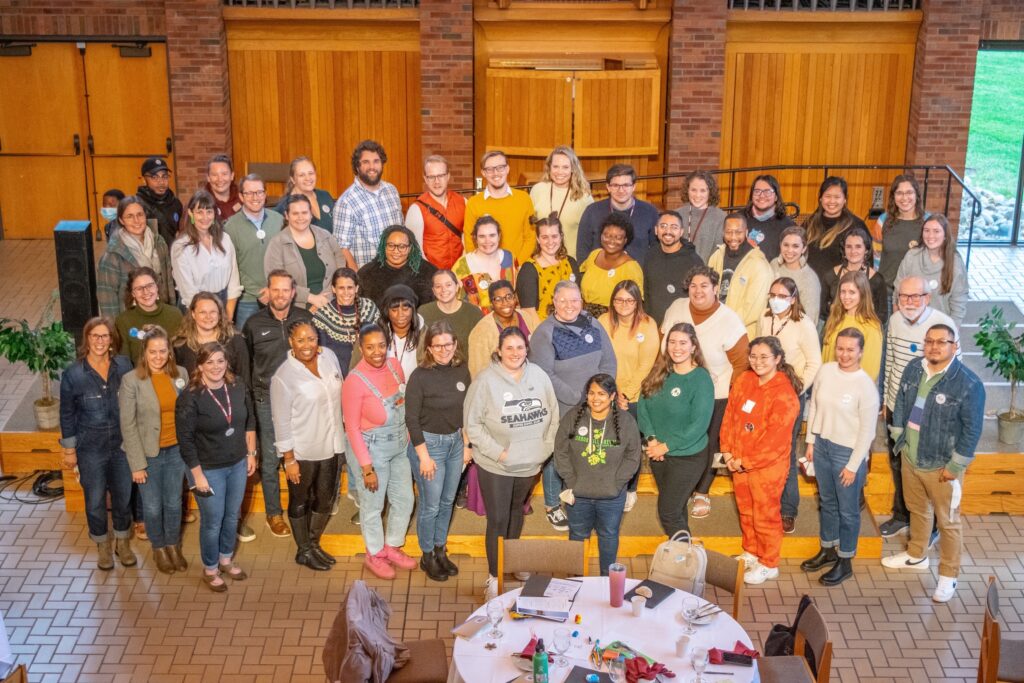 years ago we hosted 50 young adults from around the US at Augsburg for a weekend of storytelling and listening. The reason for this gathering was to unearth the common hopes, concerns and desires young adults hold for the church and the world we share. In sifting through the stories shared, we hoped to distill themes that might give shape to a book we wanted to create – one written by young adults to the church. This book was one of the ways Riverside Innovation Hub was committed to stewarding what we learned in our first five years of the Lilly Endowment’s Young Adult Initiative. After working with congregations and young adults in our inaugural round of the Riverside Innovation Hub, supported through the Lilly Endowment, we were granted additional funding and time to share the wisdom and learnings that emerged. Who better to speak those truths than the young adults themselves?
years ago we hosted 50 young adults from around the US at Augsburg for a weekend of storytelling and listening. The reason for this gathering was to unearth the common hopes, concerns and desires young adults hold for the church and the world we share. In sifting through the stories shared, we hoped to distill themes that might give shape to a book we wanted to create – one written by young adults to the church. This book was one of the ways Riverside Innovation Hub was committed to stewarding what we learned in our first five years of the Lilly Endowment’s Young Adult Initiative. After working with congregations and young adults in our inaugural round of the Riverside Innovation Hub, supported through the Lilly Endowment, we were granted additional funding and time to share the wisdom and learnings that emerged. Who better to speak those truths than the young adults themselves? 
